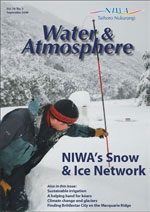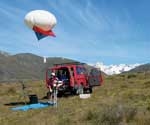PDF of this article (96 KB)


Whether it’s crossing the western Pacific to Osaka on a bulk carrier or chasing helicopters through New Zealand bush, Tony Bromley gets around. His years of experience and his expertise in making atmospheric measurements in the field have taken him from one end of the country to the other, and quite a distance offshore as well. Tony’s work encompasses devising the sampling regime to get the required data, field logistics, collecting samples, and analysing the data, right through to writing up the results in technical reports and journal articles.
How did you get into your line of work?
Right out of high school, I signed on with the New Zealand Meteorological Service so I could go and work on Campbell Island. The Service trained me in-house as a meteorologist: in one intensive year they put us through the equivalent of the University of London’s three-year met course. During my time with the Service, I worked in the research division, rising to Chief Technical Officer. My tour of duty included work as a met observer in the Christchurch office, two years on Campbell Island, and several stints in the Antarctic. Eventually I was transferred to the service’s head office at Kelburn in Wellington. When the Crown Research Institutes were created in 1992, meteorological research was moved from what became today’s MetService to NIWA. When I got back from the Antarctic that year, I had become an employee at NIWA.
Best memories of working with the Meteorological Service?
Getting to work in the Antarctic was a real privilege. Over the years, I’ve managed to get there five times. In 1968–69, I helped build Vanda Station in the Dry Valleys region and over-wintered there twice as meteorologist and team leader. I’ve also done atmospheric fieldwork on the Ross Ice Shelf and at Cape Byrd, and measured stratospheric ozone at Arrival Heights. In 1978, I was honoured to receive the British Polar Medal.
What do you do at NIWA?
The group I’m in is called TROPAC (Tropospheric Physics and Chemistry) – our work revolves around sampling and analysing the gases in the lower atmosphere. The projects I’m involved in range from testing urban air quality using our mobile laboratory, to crossing the Pacific on container vessels, to sample air mid-ocean. We regularly sample at Baring Head near Wellington; it’s a relatively accessible place to sample really ‘clean’ air originating from the Southern Ocean. We also do things like measuring greenhouse gas emissions such as methane and nitrous oxide from farmland all around the country and providing meteorological support for aerial surveys of power transmission lines. And MAF Biosecurity New Zealand has us on 24/7 standby in case there’s an outbreak of airborne pest or disease.
Sounds pretty serious. What does that mean for you and your team?
Our role is to model airborne spread. I organise the response: we have two hours to get our systems up and running. Field teams have to mobilise to set up instruments and take met measurements, then, once we have data, get the modellers going. I have to ensure the system gets activated quickly – MAF BNZ expects results from within those first two hours. We run monthly drills by simulating outbreaks so we can be sure our instruments and models are always ready.
The pests might include fire ants, gypsy moth, or painted apple moth. The airborne disease we’ve been most involved with is foot and mouth. So far, there’s only been that 2005 hoax at Waiheke Island. If there’s ever a real outbreak, it will take a couple of weeks to become evident and part of our job will be to model the met conditions for that period and trace where the virus may already have spread.
Can you describe a typical day on one of your projects?
One example would be measuring agricultural gas emissions – methane and nitrous oxide. We set up our mobile lab on a farm and a team of three people makes day-and-night measurements continuously for anything from two weeks to a month. (So it’s more like a typical day and night in the field!) What we’re looking for is how the gases rising from the field vary over time and distance from the ground.
We use met balloons such as Helikites and kytoons to lift instruments into the air to measure the gases at height. We also set up masts with tubing to collect gas samples at various heights – typically half a metre, two metres, and four metres. The tubes feed into gas chromatographs so we get continuous readings of methane and nitrous oxide. We also have a new instrument called a tunable diode laser (TDL) that can measure small differences of flux in a particular gas as it comes out of the soil. Besides using these measurements to characterise a paddock’s emissions, we can also use them to assess how well mitigation measures are working.
What’s the worst and the best your fieldwork can offer?
A little discomfort aside, there’s not a ‘worst’ because you always make the best of it and it’s fun to have the challenge of devising the ways and means to get the measurements you’re after. I enjoy getting on with the rest of the TROPAC team, and also the extreme varietyof the work we do.
Read more about it
Tony’s field work with the power transmission lines featured in Water & Atmosphere last year: Bulleid, J.; Bromley, T.; Clarkson, T.; Elley, G. (2007). Characterising the national grid. Water & Atmosphere 15(4): 24–25.
